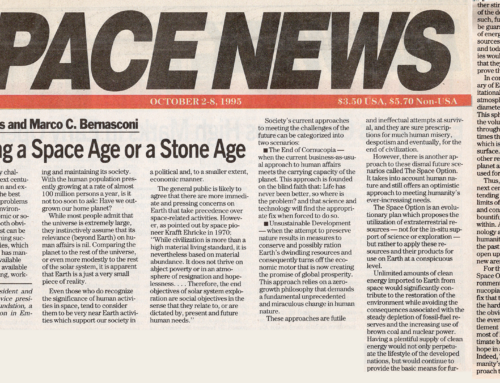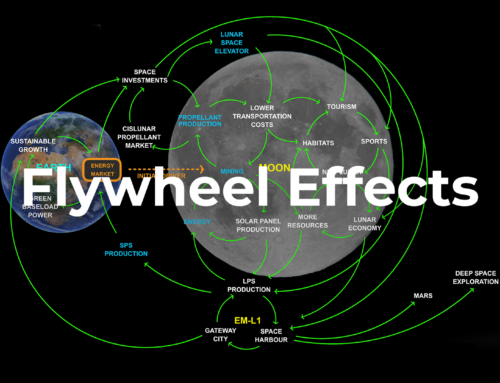Here on Earth, human civilization has reached such a point in its development where it has evolved the means to leave its home planet and to begin operating in the environment beyond the atmosphere. Optimistically, this development would enable humanity to utilize this technological capability to harness the infinite resources located off Earth to improve the well-being of the population in the decades and centuries ahead – both on Earth and beyond. On the other hand, this same capability could also be used to exert tyrannical control over much of the population thereby limiting prosperity to a select few, or, in the ultimate worst case, it could be used to destroy civilization and humanity’s only chance of expansion into the Cosmos.
Gerard K. O’Neill once posed the following question (1):
“Is a planetary surface the right place for an expanding technological civilization?”
O’Neill’s question concisely encapsulates the idea of a Cosmic Choice – an evolving technological species existing on a planet with finite resources is faced with the ultimate challenge of maintaining its development and the viability of its civilization before it reaches the threshold of unsustainability and/or the possibility of collapse. To meet this challenge, it will need additional resources beyond those that are available to it on its home planet as well as an expanded environment that will stimulate the further development of its technological capabilities.
Most people intuitively assume and fundamentally believe that terrestrial problems must have terrestrial solutions. This is obviously due to a lack of understanding about our interconnectedness and interdependence with the rest of the Cosmos. As a terrestrially evolved organism, it is in our genes to adapt to our immediate environment as we have over millions of years.
Only recently have we begun to become aware of how celestial events affect our lives. We now know that such events have been critically important to the evolution of life on Earth. Impacts of comets most likely provided a young Earth with the necessary water and perhaps even the necessary genetic materials for life to appear. Subsequent impacts by large asteroids are believed to have resulted in mass extinctions of life at various times in the history of our planet. The cycles of the Sun have resulted in a number of cold periods or ice-ages where life had to struggle to survive and numerous warm periods where life blossomed and spread. Due to the gravitational influence of the Sun and the Moon, tidal effects slowed Earth’s rotational period to its current 24 hours and played a significant role in the early evolution of life as the enormous tidal forces may have catalyzed reactions within the organic soup of early Earth. The Moon also has a stabilizing effect on Earth’s obliquity – axial tilt – which is responsible for the four seasons, and which has enabled life to exist in all regions of the planet.
And now, in recent times, human civilization has become increasingly dependent on technological assets located in space. Removing these space assets would pose dire consequences to the functioning of our complex technological society. As such, humanity’s future on Earth is irrevocably linked to its future in space.
The Space Option concept was introduced as an evolutionary plan to meet the basic and anticipated needs of humanity through the utilization of near-Earth resources - not only for the in-situ support of science or exploration – but additionally to apply these resources and/or their products for use on Earth at a conspicuous level. Most immediately, the harnessing of energy from space would replace our dependence on the continued use of finite fossil fuels which are environmentally and geopolitically negative. Alternative terrestrial energy resources – nuclear, wind and ground solar – while necessary, can never be deployed on a scale sufficient to meet the growing needs and demands of present and future populations (2).
As Krafft Ehricke wrote in 1970 (3):
“While civilization is more than a high material living standard, it is nevertheless based on material abundance. It does not thrive on abject poverty nor in an atmosphere of resignation and hopelessness. It needs vigor as well as vision. Therefore, the end objectives of solar system exploration are social objectives in the sense that they relate to, or are dictated by, present and future human needs.”
Having an inexhaustible supply of clean energy and other natural resources would not only perpetuate the lifestyle of the developed nations but would provide the basic means for further stimulating the economies of the developing countries. As such, future generations would be guaranteed a sufficient supply of energy and other material resources for their further development and today’s less fortunate societies would be provided with hope that they, too, could still aspire to improve their living standard beyond their present situation. If human civilization can be established beyond Earth, then the chances for its ultimate survival on Earth will correspondingly increase.
Therefore, a truly international effort dedicated to providing clean energy from space and to settle the Moon would be extraordinary opportunities to inspire and unite humanity to achieve its ultimate potential while addressing the critical societal issues related to the climate, the environment, economics, and energy security. If implemented in time and with sufficient commitment, the ultimate reward would be a prosperous and dynamic planetary civilization living in a healthy environment as well as the creation of an infrastructure in space upon which the expansion of the human species throughout the solar system could be realistically anticipated.
In 1987, in his book The Overview Effect, Frank White wrote (4):
“War and space exploration are alternative uses of the assertive, exploratory energies that are so characteristic of human beings. They may also be mutually exclusive because if one occurs on a massive scale, the other probably will not.”
In this context, the primary contribution of the Space Option to end our species’ propensity to engage in war resides in the fact that it carries with it an authentic hope, a challenge and a potential which may be able to compensate for the confusion, the despair, and the misery of the philosophy of a finite world expressed in the practice of war which is humanity’s main obstacle to becoming a spacefaring species. By embracing the Space Option, the aggressive aspects of human nature could be channeled towards conquering the space frontier instead of being nurtured in the pursuit of war. Indeed, the International Space Station has been a remarkable example of peaceful cooperation in space. This tension-reducing potential is perhaps the greatest contribution of the Space Option to peace and security on Earth.
However, by not embracing the Space Option, the possibility that we will be overrun by one or more of the many threats to our survival will increase and, likewise, our chances of ever becoming a spacefaring species will diminish. Today, humanity is in precisely this critical situation. It must choose between a Space Age or a Stone Age. The Space Option represents humanity’s Cosmic Choice.
Arthur Woods, April 2022
***
The Space Option concept was introduced by Arthur R. Woods and Marco C. Bernasconi in the 1990’s and has appeared in numerous publications and reports including ESA’s Vision 2020 documents “Rendezvous with the New Millennium – the Report of ESA’s Long Term Space Policy Committee”. (5). Website: https://thespaceoption.com
The Space Option Star (S.O.S.) project can be accessed here: https://spaceoptionstar.space
In 2020 the Space Option Star was selected by the European Space Agency from 201 submissions as a possible future mission idea (6) : ideas.esa.int
S.O.S. video: ‘A Star is Born’
References:
- Stewart Brand, (1975). “Is the surface of a planet really the right place for an expanding technological civilization?” — Interviewing Gerard O´Neill. pp 22-30. In: Stewart Brand, Ed (1977). Space Colonies. A Co-Evolution Book/ Whole Earth Catalog/ Penguin Books
- Marco C. Bernasconi & Arthur R. Woods, (1993). Implementing the Space Option: Elaboration and Dissemination of a New Rationale For Space. (Part 1 & Part 2) – Paper IAA.8.1-93-764 a & b presented at the 44th International Astronautical Congress, Graz, Austria. October 16-22.
- Krafft A. Ehricke, (1970). In-Depth Exploration of the Solar System and Its Utilization for the Benefit of Earth. Annals New York Academy of Sciences 187, 427-456.
- Frank White, (1987). The Overview Effect: Space Exploration and Human Evolution, pp.126, Houghton Mifflin Company, Boston
- Arthur R. Woods & Marco C. Bernasconi, (1995). Choosing A Space Age Or A Stone Age. This essay is a slightly updated version which appeared in Space News – Oct. 2- 8, 1995
https://thespaceoption.com/choosing-a-space-age-or-a-stone-age/ - ESA Campaign: What’s next? New space mission ideas and concepts






